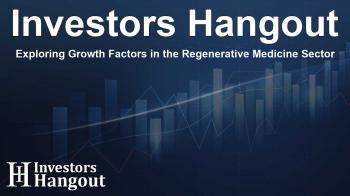Exploring Growth Factors in the Regenerative Medicine Sector

The Future of Regenerative Medicine
The Regenerative Medicine market is on a remarkable trajectory, with projections indicating it will reach USD 115.6 billion by 2029. This growth, driven by a compound annual growth rate (CAGR) of 19.2%, reflects the increasing significance of this field in modern medical practices.
Market Overview and Growth Drivers
The global Regenerative Medicine market, valued at approximately USD 33.37 billion in 2022, is set for significant expansion. This growth is largely attributed to advancements in cell therapy, tissue engineering, and the utilization of biomaterials. Researchers and healthcare providers are increasingly focused on treating various conditions, including orthopedic and cardiovascular diseases, which have garnered considerable attention due to their prevalence in an aging population.
The Impact of Chronic Diseases
Chronic diseases, comprising diabetes, cardiovascular issues, and neurodegenerative disorders, significantly affect millions worldwide, leading to tissue and organ damage. Unlike traditional therapies that primarily manage symptoms, regenerative medicine aims to repair or replace damaged tissues, offering significant advantages in treatment effectiveness.
Aging Population Effects
An older global demographic presents continual challenges for healthcare systems. This population is more prone to degenerative diseases and chronic conditions, necessitating advanced therapies. Regenerative solutions, such as stem cell therapies, are increasingly being utilized to address age-related ailments like osteoarthritis and macular degeneration.
Key Market Trends and Innovations
Several key trends are shaping the regenerative medicine landscape. Firstly, regulatory approvals for innovative therapies have surged, allowing for quicker access to necessary treatments. This acceleration in regulatory support fuels growth and inspires investment in new and potentially ground-breaking therapies. Additionally, the collaboration between biotech firms and academic institutions fosters a rich environment for research innovation.
Cell and Tissue Engineering Growth
Cell therapy stands as a pivotal aspect of regenerative medicine, capable of renewing damaged tissues and organs. The introduction and increasing acceptance of both autologous and allogeneic cell therapies address unmet medical needs, particularly within oncology and neurology fields. Similarly, advances in tissue engineering provide alternatives to traditional organ transplants, significantly enhancing patient outcomes in reconstructive surgeries.
Orthopedic Applications
Orthopedic applications are among the most established sectors of regenerative medicine. Conditions related to bones and cartilage, resulting from sports injuries or degenerative diseases, have spurred demand for innovative treatments like stem cell-based cartilage repairs and bioengineered implants. As more orthopedic clinics integrate biologic solutions into practice, the regenerative medicine sector continues to expand in response to patient needs.
Market Dynamics and Regional Insights
North America currently leads the global market, capturing about 25% of the share, bolstered by significant investment in R&D and a robust regulatory framework. European countries are also witnessing growth, driven by academic research and government funding initiatives.
Among product segments, tissue engineering dominates, accounting for over 40% of the market. A surge in dermatology, cardiovascular applications, and orthopedic solutions further highlights the diversified applications of regenerative therapies across distinct medical fields.
Leading Companies in Regenerative Medicine
A variety of companies are pivotal in this evolving landscape. Notable names include J&J (DePuy Synthes), Medtronic Inc, Zimmer Biomet, and Stryker, among others. Their innovations continue to propel the market forward as they develop cutting-edge treatments that incorporate regenerative technologies.
Summary and Future Directions
As the regenerative medicine sector evolves, the focus on addressing chronic conditions via innovative therapies positions it as a key player in future healthcare solutions. The interdisciplinary collaboration among various stakeholders fosters a strong foundation for continued advancements and successful market growth. Additionally, as consumer awareness increases, healthcare providers and institutions are prioritizing regenerative solutions that promise long-term benefits and sustainability.
Frequently Asked Questions
What is the projected value of the Regenerative Medicine market by 2029?
It is projected to reach USD 115.6 billion by 2029.
What are the main factors driving the growth of this market?
Advancements in cell therapy, tissue engineering, and increasing prevalence of chronic diseases.
What role does aging population play in regenerative medicine?
An aging population increases the demand for regenerative treatments as older adults are more susceptible to degenerative diseases.
Which geographical area dominates the Regenerative Medicine market?
North America holds the largest share of the market, around 25%.
What sectors benefit significantly from regenerative medicine?
Key sectors include orthopedic, dermatology, and cardiovascular applications.
About The Author
Contact Dominic Sanders privately here. Or send an email with ATTN: Dominic Sanders as the subject to contact@investorshangout.com.
About Investors Hangout
Investors Hangout is a leading online stock forum for financial discussion and learning, offering a wide range of free tools and resources. It draws in traders of all levels, who exchange market knowledge, investigate trading tactics, and keep an eye on industry developments in real time. Featuring financial articles, stock message boards, quotes, charts, company profiles, and live news updates. Through cooperative learning and a wealth of informational resources, it helps users from novices creating their first portfolios to experts honing their techniques. Join Investors Hangout today: https://investorshangout.com/
The content of this article is based on factual, publicly available information and does not represent legal, financial, or investment advice. Investors Hangout does not offer financial advice, and the author is not a licensed financial advisor. Consult a qualified advisor before making any financial or investment decisions based on this article. This article should not be considered advice to purchase, sell, or hold any securities or other investments. If any of the material provided here is inaccurate, please contact us for corrections.

